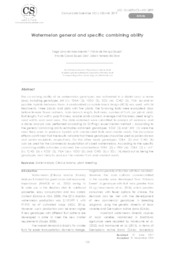Watermelon general and specific combining ability.
Watermelon general and specific combining ability.
Author(s): NASCIMENTO, T. L. do; SOUZA, F. de F.; DIAS, R. de C. S.; SILVA, E. F. da
Summary: The combining ability of six watermelon genotypes was estimated in a diallel cross scheme (6x6), including genotypes JNY (1), ?ORA? (2), ?KOD? (3), ?SOL? (4), ?CHG? (5), ?PEA? (6) and all possible hybrids between them. A randomized complete block design (RCB) was used, with 36 treatments, three blocks, and plots with five plants. The following traits were evaluated: days before female flower anthesis, main branch length, fruit mass, number of fruits per plant, yield, fruit length, fruit width, pulp firmness, soluble solids content, average rind thickness, seed length, seed width, and seed mass. The data obtained were submitted to analysis of variance, and a diallel analysis was performed according to Griffing?s experimental method I. According to the general combining ability estimates obtained, genotypes ?KOD? (3) and ?JNY? (1) were the most likely ones to produce hybrids with smaller-sized fruits and smaller seeds. The reciprocal effects confirmed that the results indicate that these genotypes should be used as pollen donors and pollen recipients, respectively. On the other hand, genotypes ?ORA? (2) and ?CHG? (5) can be used for the commercial exploitation of sliced watermelons. According to the specific combining ability estimates obtained, the combinations ?ORA? (2) x ?PEA? (6), ?ORA? (2) x ?JNY? (1), ?CHG? (5) x ?KOD? (3), ?PEA? (6) x ?KOD? (3), and ?CHG? (5) x ?SOL? (4) stood out as being the genotypes most likely to produce the smallest fruits and smallest seeds.
Publication year: 2019
Types of publication: Journal article
Unit: Embrapa Semi-arid Region
Observation
Some of Embrapa's publications are published as ePub files. To read them, use or download one of the following free software options to your computer or mobile device. Android: Google Play Books; IOS: iBooks; Windows and Linux: Calibre.
Access other publications
Access the Agricultural Research Database (BDPA) to consult Embrapa's full library collection and records.
Visit Embrapa Bookstore to purchase books and other publications sold by Embrapa.

